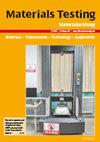Decarburization effects on high-cycle fatigue of uncoated press hardened steels
IF 3.5
4区 材料科学
Q2 MATERIALS SCIENCE, CHARACTERIZATION & TESTING
引用次数: 0
Abstract
Abstract The decarburization layer can be detrimental and lead failures in press hardened steels. This work investigates the effect of decarburization layer on the fatigue crack origination and growth on press hardened parts of uncoated 22MnB5 steel. The decarburization layer was analyzed by light microscope, scanning electron microscope, and microhardness measurements. It was found that decarburization layer has two distinct zones indicating complete and partial decarburization. To understand the effect of decarburization on crack origination, high cycle fatigue tests were performed on samples from press hardened parts in decarburized and polished (nondecarburized) conditions. The results have shown that the fatigue performance of press hardened steels in polished condition outperforms the fatigue samples in decarburized condition. In fractographic investigations, it was seen that decarburization is not only responsible for crack origination but also affects crack propagation by having full and partial decarburization zones. The full decarburization zone was acted as surface crack origination source. In the partial decarburization zone, the crack propagation behavior was changed by a complex phase microstructure of bainite, ferrite, and martensite.脱碳对未涂覆压硬化钢高周疲劳的影响
脱碳层是冲压淬火钢的重要组成部分,是导致其失效的主要原因。研究了脱碳层对未涂层22MnB5钢冲压硬化件疲劳裂纹产生和扩展的影响。采用光镜、扫描电镜和显微硬度测试对脱碳层进行了分析。结果表明,脱碳层有完全脱碳和部分脱碳两个区域。为了了解脱碳对裂纹产生的影响,对脱碳和抛光(非脱碳)条件下的冲压硬化零件样品进行了高周疲劳试验。结果表明,淬硬钢在抛光状态下的疲劳性能优于脱碳状态下的疲劳试样。断口形貌研究发现,脱碳不仅是裂纹形成的重要原因,而且还会产生完全脱碳区和部分脱碳区,从而影响裂纹扩展。完全脱碳区是表面裂纹的产生源。在部分脱碳区,裂纹扩展行为由贝氏体、铁素体和马氏体组成的复杂相组织改变。
本文章由计算机程序翻译,如有差异,请以英文原文为准。
求助全文
约1分钟内获得全文
求助全文
来源期刊

Materials Testing
工程技术-材料科学:表征与测试
CiteScore
4.20
自引率
36.00%
发文量
165
审稿时长
4-8 weeks
期刊介绍:
Materials Testing is a SCI-listed English language journal dealing with all aspects of material and component testing with a special focus on transfer between laboratory research into industrial application. The journal provides first-hand information on non-destructive, destructive, optical, physical and chemical test procedures. It contains exclusive articles which are peer-reviewed applying respectively high international quality criterions.
 求助内容:
求助内容: 应助结果提醒方式:
应助结果提醒方式:


